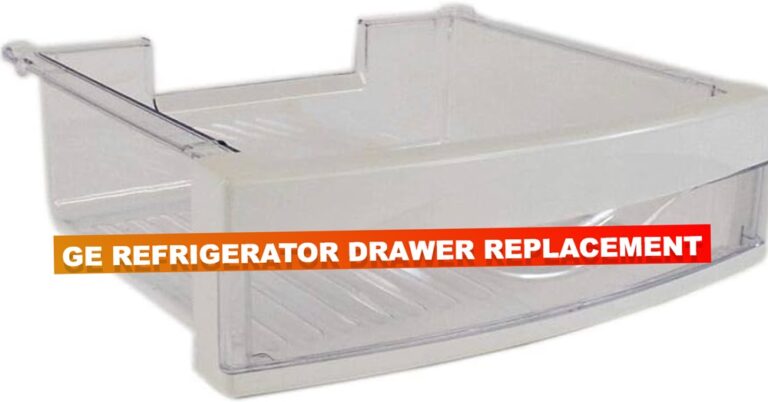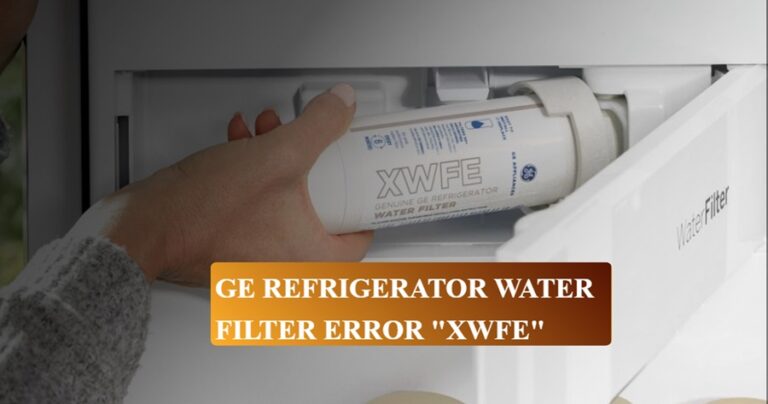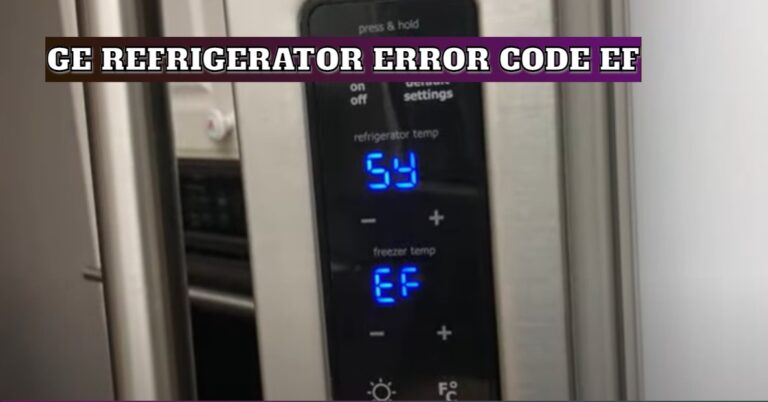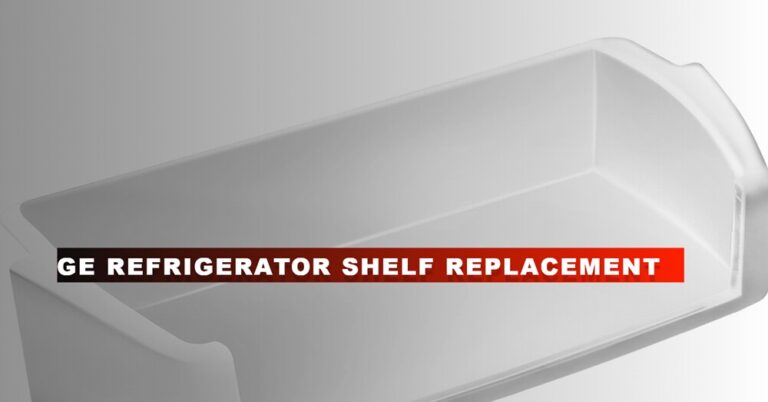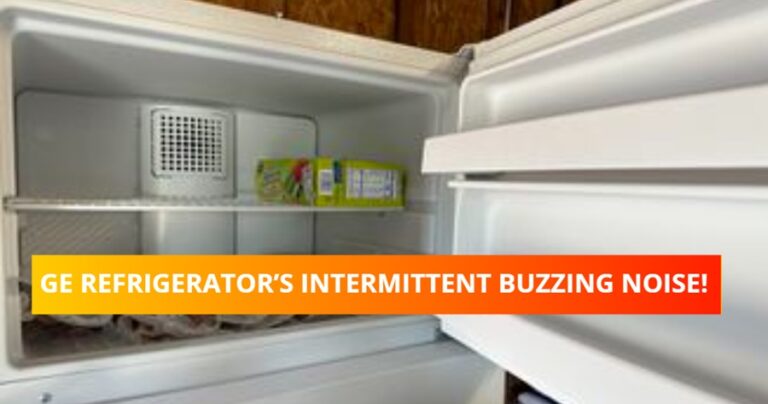Your GE refrigerator not making ice but water works may be due to a faulty water inlet valve or a clogged water filter. Consider checking and replacing these parts to resolve the issue.
Having a properly functioning refrigerator is crucial for storing food and beverages at the right temperature. However, when you find that your GE refrigerator is not making ice while the water dispenser still works, it can be frustrating. Understanding the possible causes of this problem can help you troubleshoot and fix it quickly.
This article will explore two common reasons that can lead to this issue: a faulty water inlet valve or a clogged water filter. By addressing these potential culprits, you can get your GE refrigerator back to making ice efficiently. Let’s dive in and find out more about these troubleshooting steps.

Credit: www.youtube.com
Possible Causes
Possible causes for a GE refrigerator not making ice but still dispensing water could be a malfunctioning ice maker, a clogged water filter, or issues with the water inlet valve. Check these components to troubleshoot the problem and ensure a continuous supply of ice. If your GE refrigerator is not making ice but the water dispenser is working fine, there could be several possible causes.
Clogged Water Filter
A clogged water filter is a common reason why your GE refrigerator might not be making ice. A water filter is designed to remove impurities from the water supply, ensuring clean and fresh ice. Over time, the filter can become clogged with sediment and mineral deposits, restricting water flow to the ice maker. If the water flow is restricted, the ice maker won’t be able to produce ice cubes.
Faulty Water Inlet Valve
The water inlet valve is responsible for supplying water to the ice maker. If this valve is faulty or malfunctioning, it can prevent water from entering the ice maker, resulting in no ice production. A faulty water inlet valve can be caused by a variety of issues, such as a stuck solenoid or a clogged inlet valve screen. Without proper water flow, the ice maker won’t be able to produce ice.
Ice Maker Malfunction
If the water filter and water inlet valve are functioning properly, the issue might lie with the ice maker itself. The ice maker unit consists of several components, including the motor, thermostat, and heating element. If any of these components are faulty or damaged, it can affect the ice-making process. For example, a malfunctioning thermostat may not signal the ice maker to initiate the freezing process, resulting in no ice production.
Additionally, a broken motor or heating element can prevent ice cubes from being properly formed and released. In summary, if your GE refrigerator is not making ice but the water dispenser is working fine, the possible causes could be a clogged water filter, a faulty water inlet valve, or an ice maker malfunction. Checking these components and addressing any issues can help resolve the problem and get your ice maker back to producing ice cubes.
Troubleshooting Steps
Is your GE refrigerator not making ice? Don’t worry, we’ve got you covered! Follow these simple troubleshooting steps to identify the problem and get your ice maker up and running again.
Check Water Filter
The first thing to check when your GE refrigerator is not making ice is the water filter. A clogged or expired water filter could be preventing water from flowing into the ice maker. Here’s what you can do:
- Locate the water filter in your refrigerator. It is usually located in the upper right corner of the refrigerator compartment.
- Remove the water filter by turning it counterclockwise and pulling it out.
- Inspect the water filter for any signs of clogging or damage. If it is dirty or appears to be past its expiration date, it’s time to replace it.
- Install a new water filter by inserting it into the filter housing and twisting it clockwise until it locks into place.
- Flush the water system by dispensing water from the refrigerator water dispenser for a few minutes. This will help remove any air and debris from the system.
Inspect the Water Inlet Valve
If the water filter is not the issue, the next step is to check the water inlet valve. The water inlet valve controls the flow of water into the ice maker. To inspect the water inlet valve:
- Unplug the refrigerator from the power source.
- Locate the water inlet valve at the back of the refrigerator, usually near the bottom.
- Inspect the valve for any signs of leakage, blockage, or damage. If you notice any issues, the water inlet valve may need to be replaced.
- If the valve appears to be in good condition, you can perform a continuity test using a multimeter to ensure it is functioning properly.
- If the water inlet valve is found to be faulty, it is recommended to contact a professional technician for replacement.
Test The Ice Maker
If the water filter and water inlet valve are not the culprits, it’s time to test the ice maker itself. Follow these steps to test the ice maker:
- Ensure the ice maker is turned on. Look for the ice maker switch or button on your refrigerator’s control panel and make sure it is in the “On” position.
- Inspect the ice maker for any ice build-up or obstructions that may be preventing it from functioning properly. Remove any ice jams and clear any debris.
- If the ice maker still does not work, you can try resetting it. Look for a small reset button on the ice maker and press it for a few seconds.
- Wait for a few hours to see if the ice maker starts producing ice. If it does not, it may be time to call a technician for further assistance.
By following these troubleshooting steps, you can often resolve the issue of your GE refrigerator not making ice. Remember to consult your refrigerator’s user manual for specific instructions related to your model.
Fixing Clogged Water Filter
A common issue with GE refrigerators is when the ice maker stops working while the water dispenser continues to function properly. This can be frustrating, especially when you rely on ice for refreshing beverages or for preserving perishable items. One possible cause of this problem is a clogged water filter. In this section, we will guide you through the steps to fix a clogged water filter and get your ice maker working again.
Locate And Remove The Water Filter
To begin, you need to locate the water filter in your GE refrigerator. The exact location may vary depending on the model, but it is typically found inside the refrigerator compartment, either at the top, bottom, or rear. Refer to your refrigerator’s user manual or check the manufacturer’s website for specific instructions on where to find the water filter in your model. Once you have located the water filter, follow these steps to remove it:
- Make sure to turn off the ice maker and the water supply to your refrigerator before removing the filter.
- Gently rotate the filter counterclockwise until it unlocks from the filter housing.
- Pull the filter straight out to remove it.
Clean Or Replace The Water Filter
After removing the clogged water filter from your GE refrigerator, you have two options – either clean or replace it. Here’s what you can do:
Cleaning the Water Filter:
- Inspect the water filter for any visible debris or sediments.
- If you notice any blockages, rinse the filter under cold water to remove the buildup.
- Use a soft-bristle brush, if necessary, to gently scrub away any stubborn residue.
- Once cleaned, reinstall the filter by inserting it into the filter housing and rotating it clockwise until it locks into place.
- Remember to turn on the water supply and the ice maker after installing the cleaned filter.
Replacing the Water Filter:
If the water filter is heavily clogged or if it has been in use for more than six months (as recommended by GE), it is best to replace it. Follow these steps:
- Purchase a compatible replacement water filter from a trusted retailer or directly from the manufacturer.
- Take note of the model number or part number of your refrigerator to ensure you get the correct filter.
- Remove the packaging from the new filter and insert it into the filter housing.
- Rotate the filter clockwise until it locks into place.
- Turn on the water supply and the ice maker once the new filter is installed.
By either cleaning or replacing the water filter, you have addressed a potential cause of your GE refrigerator not making ice. If the problem persists after following these steps, there may be other underlying issues that require professional assistance. However, in most cases, a clogged water filter is the culprit, and resolving it will restore the ice-making functionality of your refrigerator.
Fixing Faulty Water Inlet Valve
Fixing a faulty water inlet valve is essential if your GE refrigerator isn’t making ice but the water dispenser is still working. This simple repair will ensure that the ice maker can function properly again.
Check Water Supply
To start troubleshooting your GE refrigerator not making ice but water working, the first thing you need to do is check the water supply. Make sure the water dispenser is functioning properly and producing a steady flow of water. If water is not coming out or the flow is slow, it could indicate a problem with the water supply line or the filter.
Check if the water supply valve is fully open and the water line is not kinked or frozen. If necessary, replace the water filter to ensure a clean and unrestricted water flow.
Inspect And Replace the Water Inlet Valve
If the water supply is not the issue, the next step is to inspect the water inlet valve. The water inlet valve is responsible for controlling the flow of water to both the dispenser and the ice maker. Over time, the valve can become faulty or get clogged with debris, resulting in a lack of water reaching the ice maker. To inspect the water inlet valve, follow these steps:
- Unplug the refrigerator from the power source and turn off the water supply.
- Locate the water inlet valve, usually at the back of the refrigerator.
- Disconnect the water inlet valve from the water supply line.
- Check for any signs of damage or blockage in the valve.
If you notice any visible damage or debris, it is recommended to replace the water inlet valve. You can find a suitable replacement valve either from the manufacturer or a reputable appliance parts store. When installing the new valve, make sure to connect the water supply line securely and verify that there are no leaks. Finally, plug the refrigerator back into the power source and turn on the water supply to test if the ice maker is now receiving water.
By checking the water supply and inspecting/replacing the water inlet valve, you can resolve the issue of a GE refrigerator not making ice but the water dispenser still working.
Fixing Ice Maker Malfunction
Is your GE refrigerator not making ice but the water dispenser is still working? Don’t worry, you can fix this ice maker malfunction. Follow these easy steps to troubleshoot and resolve the issue, ensuring you have a steady supply of ice once again. If your GE refrigerator is not making ice but the water dispenser is working fine, there are a few potential causes and solutions to consider.
Before calling a technician, try these troubleshooting steps to fix the ice maker malfunction yourself. You may save time and money by avoiding unnecessary repairs or replacements. Below, we outline three common solutions to get your ice maker working again: Reset the Ice Maker, Check for Ice Blockage, and Replace the Ice Maker.
Reset The Ice Maker
To begin troubleshooting, attempt to reset the ice maker. This simple step can often resolve minor glitches or conflicts within the ice maker system. Follow these steps to reset the ice maker:
- Locate the ice maker control panel on the front of your GE refrigerator.
- Press and hold the reset button for approximately 10 seconds, until the indicator light turns off.
- Release the reset button and wait a few minutes for the ice maker to reset completely.
Once the reset process is complete, check if the ice maker start producing ice. If the ice maker is still not working, proceed to the next troubleshooting step.
Check For Ice Blockage
If resetting the ice maker did not solve the issue, the next step is to check for any ice blockages. Ice blockages can disrupt the ice maker’s functionality. Follow these steps to check for ice blockage and remove it if necessary:
- Open the freezer door and locate the ice bin or ice tray.
- Inspect the ice bin or tray for any visible ice blockages or clumps.
- If you find any ice blockage, carefully remove and discard it.
- Allow the ice maker to continue operating for a few hours to see if it starts producing ice.
If there is no ice blockage or removing the blockage doesn’t fix the issue, move on to the next troubleshooting step.
Replace The Ice Maker
If resetting the ice maker and removing any ice blockages did not resolve the issue, it is possible that the ice maker itself is faulty and needs to be replaced. Before replacing the ice maker, consider contacting GE customer support or a professional technician for further assistance. T
hey can provide guidance and help ensure you have the correct replacement part for your specific refrigerator model. By following these troubleshooting steps, you can often identify and resolve the issue with a GE refrigerator not making ice. Always refer to your refrigerator’s user manual or consult with a professional if you are unfamiliar with performing these steps on your own.
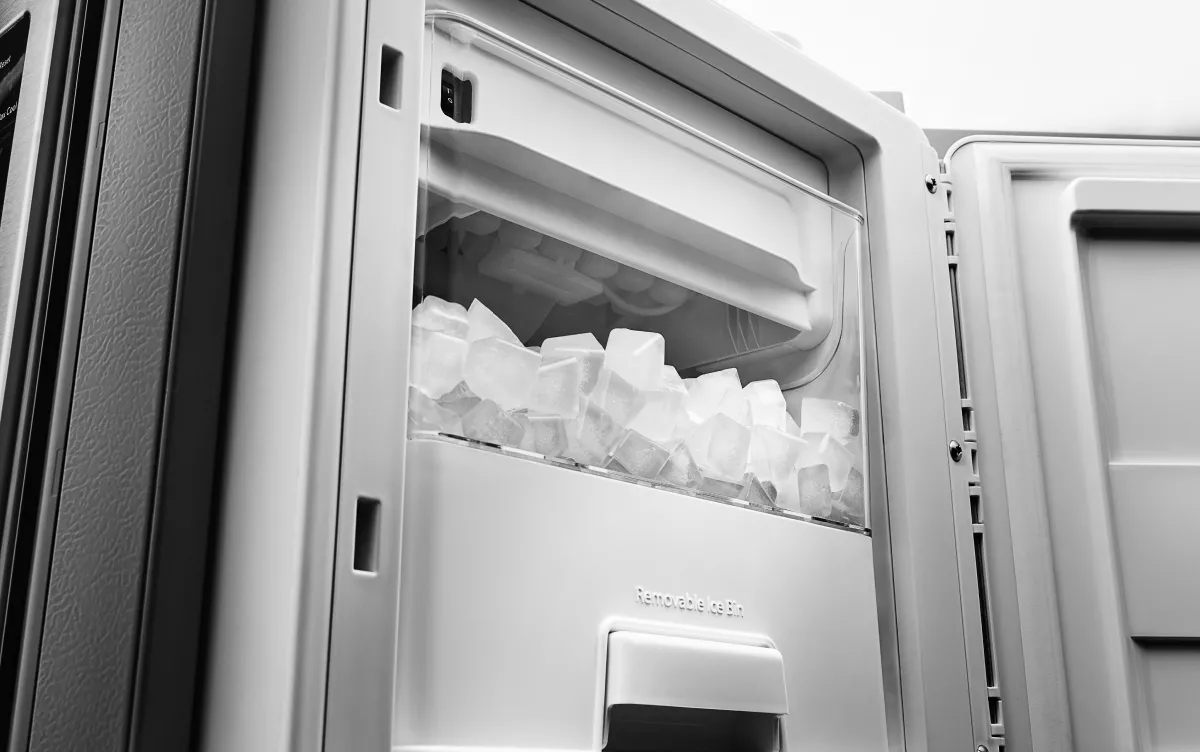
Credit: www.kitchenaid.com
Frequently Asked Questions On Ge Refrigerator Not Making Ice But Water Works
Why Is My Ge Refrigerator Not Making Ice But The Water Works?
There are several possible reasons for this issue. Check if the ice maker is turned on and if there is a blockage in the water line. Also, make sure the freezer is set to the correct temperature. If the problem persists, it might be a faulty water inlet valve or a malfunctioning ice maker assembly.
How Can I Troubleshoot My Ge Refrigerator’s Ice Maker?
First, ensure the ice maker is turned on and the water supply is working. If the freezer is not set to the recommended temperature, adjust it accordingly. Check if there is any ice blockage in the ice maker or water line.
If these steps don’t resolve the issue, you may need to consult a professional technician for further troubleshooting and repair.
What Could Be Causing My GE refrigerator’s Ice Maker To Stop Working?
Several factors can cause the ice maker to stop working. Possible issues include a malfunctioning water inlet valve, a faulty ice maker assembly, a clogged water line, or incorrect freezer temperature. It is recommended to check these components and settings to determine the cause and seek professional assistance if needed.
Conclusion
To troubleshoot your GE refrigerator not making ice but water works, make sure the water supply is uninterrupted, the water filter is clean, and the ice maker is not faulty. Regular maintenance, such as keeping the freezer temperature optimal and defrosting if necessary, can also prevent ice-making issues. By understanding the potential causes and following the steps outlined in this blog post, you can resolve the problem and enjoy ice in your refrigerator once again.
Hello Readers, I am Mechanic Shuvo, a seasoned refrigerator solution expert with over 11 years of hands-on experience in the field. Throughout my career, I've dedicated myself to understanding the ins and outs of refrigeration systems, honing my skills as a refrigerator mechanic. My passion for these appliances led me to create the website "refrigeratorsolutionsguide.com," where I aim to share my wealth of knowledge and expertise with others.
Over the years, I've encountered a wide range of refrigerator issues and have successfully resolved them all. From common problems like temperature fluctuations and strange noises to more complex technical issues, I've seen it all. Through my website, I hope to provide practical solutions, insightful tips, and guidance to help you keep your refrigerators running smoothly.


